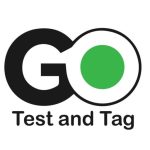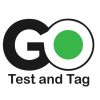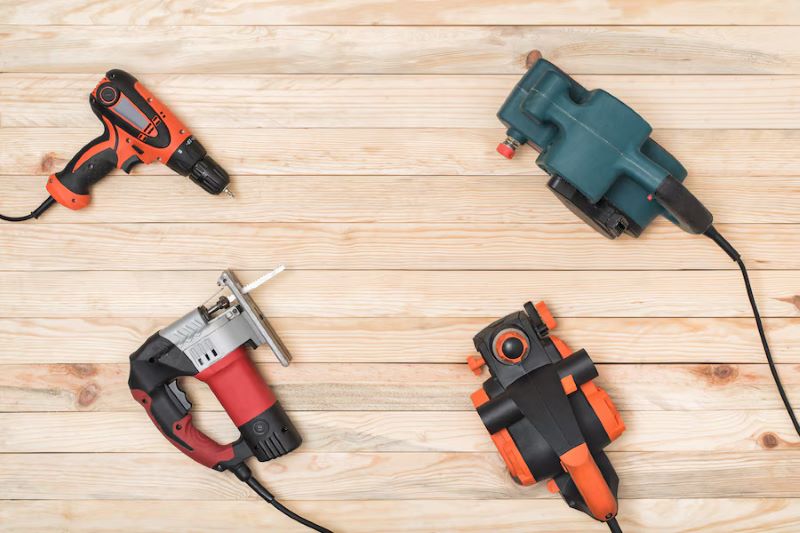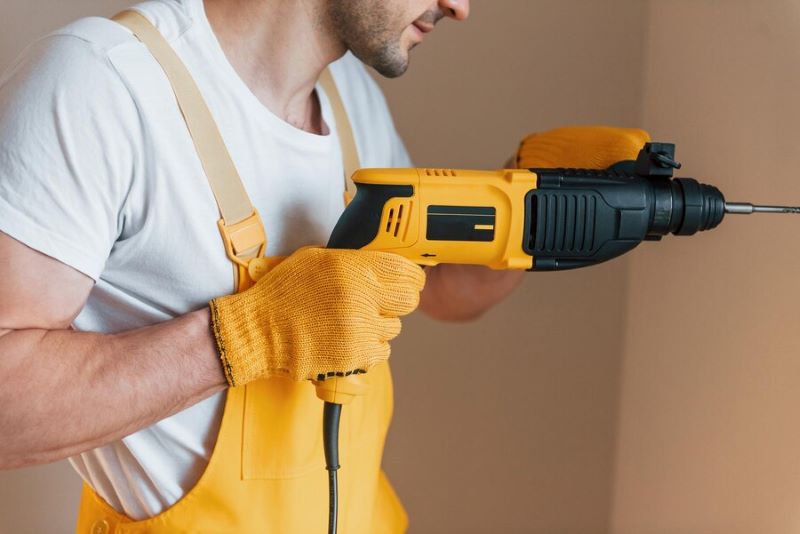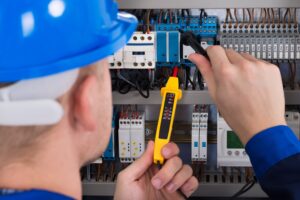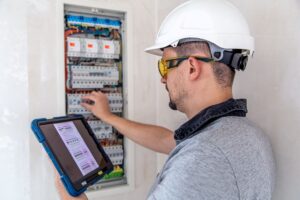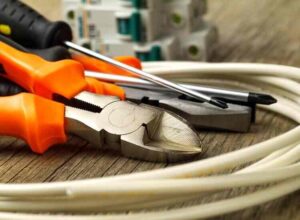Maintaining the safety of power tools in various work environments is an essential aspect of occupational health and safety. Power tools, often used in construction, manufacturing, and maintenance industries, are prone to electrical faults due to regular wear and tear. Hence, regular testing and tagging to comply with AS/NZS 3760:2022 standards is not just legally required but vital for ensuring a safe workplace. This comprehensive guide offers a detailed breakdown of the test and tag process for power tools, focusing on the steps involved for both Class I and Class II appliances, as well as the necessary tests for tools with RCDs (Residual Current Devices) and battery chargers for cordless tools.
We’ll also explore the importance of visual inspections before any testing, specific test methods for popular power tools like drills, grinders, saws, and air compressors, and the safety implications of regular testing.
The Importance of Test and Tag for Power Tools
Testing and tagging power tools is a legal requirement under AS/NZS 3760:2022, which sets the standard for electrical safety and outlines testing intervals for different types of equipment. Ensuring that power tools are regularly tested and tagged significantly reduces the risks of electrical hazards, such as electrocution, electrical fires, and malfunctioning tools that could cause severe injuries or fatalities. For employers and business owners, it’s crucial to meet these safety standards to protect employees, reduce workplace accidents, and ensure compliance with regulations.
- Identifying Faulty Equipment: Power tools are exposed to rough handling in environments like construction sites. Over time, the cords may fray, internal wiring may get damaged, or components may wear out. Testing and tagging helps in identifying these faults before they turn into hazards.
- Ensuring Compliance: Failing to comply with AS/NZS 3760:2022 standards can result in severe legal penalties, including fines or shutdowns. Compliance ensures that you meet your legal obligations and promote a safer workplace.
- Improving Workplace Safety: Regularly tested tools are safer to use, which directly impacts worker productivity and reduces downtime caused by faulty equipment. A workplace with high safety standards fosters confidence and improves morale.
Visual Inspection: The First Step in Power Tool Safety
Before conducting any electrical tests, a thorough visual inspection is the first and most critical step. This step often identifies common issues that could make a tool unsafe for testing or use, such as frayed cords, broken plugs, or exposed internal components.
During a visual inspection:
- Check for Damaged Power Cords: Worn or frayed cords are among the most common defects in power tools. If a power cord is visibly damaged, it must be replaced before any testing can be conducted.
- Look for Cracked or Broken Plugs: A damaged plug can prevent a secure connection to the power supply, leading to potential electrical hazards.
- Examine Internal Components: Any visible internal components, such as exposed wiring or broken housings, indicate that the tool is unsafe for use and should be repaired or replaced.
- Inspect Tool Housing for Cracks or Breaks: The outer casing of power tools protects the internal wiring. If there are visible cracks or breaks, moisture or debris could get inside, increasing the risk of short circuits.
If any faults are discovered during the visual inspection, the tool should not proceed to testing until it has been repaired.
How to Test and Tag Different Power Tools
Different types of power tools require specific testing methods. Let’s delve into the testing requirements for a few common types:
1. Air Compressors (Belt Drive and Direct Drive)

Basic Use: Air compressors store and release compressed air to power pneumatic tools, such as nail guns, spray painters, or tire inflators. They are widely used in industrial and construction environments.
Testing and Tagging Air Compressors:
- Class I (earthed): Requires the following tests:
- Earth Continuity Test: Ensures that the earth connection is functioning correctly. The earth wire is critical for user safety as it diverts any stray electrical currents.
- Insulation Resistance Test: Measures the integrity of the insulation to ensure there are no electrical leakages that could cause shock hazards.
- Earth Leakage Test: Detects any current leakage under normal operating conditions.
- Class II (double insulated): Requires only an insulation resistance test, as there is no earth wire in these tools. This test ensures that the double insulation is intact.
Air compressors can be single-phase or three-phase. For three-phase compressors, carry out earth leakage and insulation resistance tests.
2. Drills (Cordless and Corded)
Basic Use: Drills are versatile tools used for drilling holes and driving screws. They come in many variants, such as standard drills, hammer drills, and rotary drills, and are crucial in construction, carpentry, and general DIY tasks.
Testing and Tagging Drills:
- Corded Drills (Class I): Requires earth continuity, insulation resistance, and earth leakage tests. Ensuring the earth continuity is vital since these tools are often used in environments with moisture and dust, increasing the risk of electrical faults.
- Cordless Drills (Class II): These drills do not have an earth wire, so only the insulation resistance test is needed. Additionally, the battery charger for cordless drills must be tested for safety, as it is connected to the mains.
Cordless tools rely heavily on their chargers. Therefore, proper testing of both the tool and the charger is critical to avoid overheating or malfunctioning. Drills are usually single-phase, but heavy-duty industrial versions may be three-phase. For three-phase drills, conduct earth leakage and insulation resistance tests.
3. Grinders (Angle Grinders, Bench Grinders)

Basic Use: Grinders are powerful tools used for grinding, cutting, or polishing various materials, including metal, wood, and concrete.
Testing and Tagging Grinders:
- Corded Grinders (Class I): Requires earth continuity, insulation resistance, and earth leakage tests. Grinders often generate a lot of dust and debris, which can accumulate in the tool, so checking for insulation damage is particularly important.
- Cordless Grinders (Class II): Insulation resistance testing is required. The battery charger must also undergo testing.
Given the high-speed operations of grinders, their regular testing is necessary to ensure that they do not pose a fire or shock hazard due to motor overheating or electrical faults. Both angle and bench grinders can be single-phase or three-phase. For three-phase grinders, perform earth leakage and insulation resistance tests.
4. Saws (Circular, Jigsaw, Mitre Saw, Table Saw)

Basic Use: Saws are commonly used for cutting through wood, metal, or plastic. They are indispensable in carpentry, construction, and manufacturing.
Testing and Tagging Saws:
- Corded Saws (Class I): Perform earth continuity, insulation resistance, and earth leakage tests. Saws are frequently exposed to dust, which can affect electrical connections.
- Cordless Saws (Class II): Insulation resistance test only, along with the testing of the battery charger.
Since saws are high-powered tools that generate significant heat and debris, regular testing is essential to avoid malfunctions. Table saws and industrial saws may operate on three-phase power, necessitating additional checks.
5. Portable Generators (Petrol and Inverter)
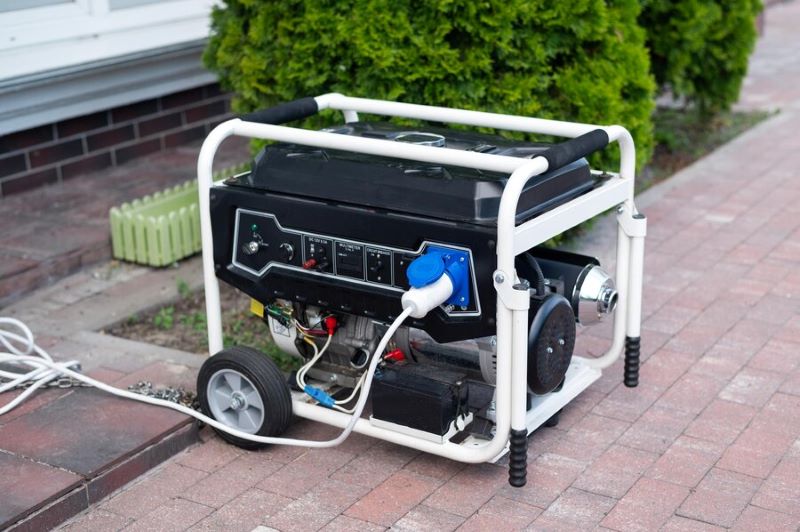
Basic Use: Portable generators supply electricity where mains power is unavailable. They are essential for outdoor work, emergency power, and construction sites.
Testing and Tagging Generators:
- RCD Trip Time Testing: Testing the RCD trip time is critical for generators to ensure that they disconnect power quickly in the event of a fault. This prevents electric shock and fire hazards.
- Earth Continuity and Insulation Resistance: Verifying the integrity of the earth connection and insulation helps to ensure that the generator operates safely.
Generators, whether single-phase or three-phase, must be regularly tested due to their critical role in providing safe and reliable power. The RCD trip time test is especially important for portable generators used in areas where immediate power shutdown is required during a fault.
Battery Chargers: Silent but Crucial

Cordless power tools rely on battery chargers, which must be tested even though the tools themselves don’t require direct testing. Chargers are classified as either Class I or Class II, and the testing requirements vary based on this classification:
- Class I Chargers: Earth continuity, insulation resistance, and earth leakage tests are required.
- Class II Chargers: Only insulation resistance tests are necessary.
Chargers, while often overlooked, are essential components in maintaining the safety of cordless tools. Faulty chargers can lead to overheating, electric shocks, or fire hazards, making regular testing a critical safety measure.
Additional Power Tools That Require Test and Tag
A variety of other power tools require regular testing and tagging under AS/NZS 3760:2022 standards. Some of these include:
- Biscuit Joiners: Used to join pieces of wood together. Class I variants require earth continuity, insulation resistance, and earth leakage tests.
- Blowers and Fans: Industrial fans and blowers, especially cordless versions, must undergo insulation resistance tests, with earth continuity tests for Class I versions.
- Compactors: Often used on construction sites to compact soil or asphalt, compactors need thorough testing, including earth continuity and insulation resistance tests.
By regularly testing and tagging these tools, you ensure that all electrical equipment on the job site is safe and complies with industry regulations.
Conclusion: Ensuring Safety with Regular Testing and Tagging
Power tools like drills, saws, air compressors, and generators are critical to the smooth operation of many industries. Ensuring that these tools are regularly tested and tagged as per AS/NZS 3760:2022 standards prevents workplace accidents and ensures compliance with legal requirements. Regular testing not only prolongs the life of the equipment but also helps in maintaining a safer working environment for everyone involved.
By adhering to a structured schedule for testing and tagging, you can avoid the risks associated with electrical faults, safeguard your employees, and ensure that your business operates within the regulatory framework. Additionally, regular visual inspections and timely repairs are crucial components of this process, contributing to an overall safer and more efficient workplace.
FAQs: Test and Tag Power Tools
- Do cordless power tools need to be tested?
- The cordless tool itself doesn’t need testing, but the battery charger must be tested and tagged.
- What tests are required for Class I tools?
- For Class I tools, perform earth continuity, insulation resistance, and earth leakage tests.
- Why is RCD testing necessary for generators?
- The RCD trip time test ensures that the generator’s RCD will shut off power to prevent electric shock in case of a fault.
